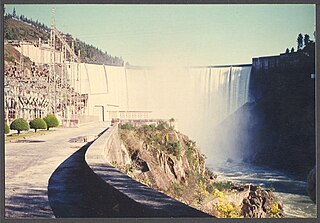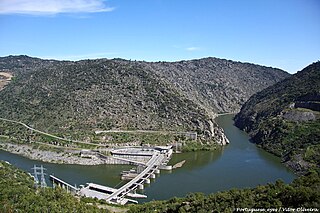
Centrais Elétricas Brasileiras S.A. is a major Brazilian electric utilities company. The company's headquarters are located in Rio de Janeiro.

Galp Energia, SGPS, S.A. is a Portuguese multinational energy corporation, headquartered in Lisbon, Portugal. Galp consists of more than 100 companies engaged in every aspect of the oil and natural gas supply, hydrocarbon exploration and production; refining, trading, logistics and retailing; co-generation and renewable energy. Galp was founded in 1999 through the merger of Petrogal, Gás de Portugal and Transgás. As of 2020, it is the largest oil and gas group in Portugal, where it distributes gas and sells petrol.

CPFL Energia (former name: Companhia Paulista de Força e Luz) is the second largest non state-owned group of electric energy generation and distribution in Brazil and the third biggest Brazilian electric utility company, after Eletrobras and Energisa. The corporation is composed by CPFL Brasil, CPFL Piratininga, CPFL Paulista, CPFL Geração, CPFL Renováveis, Rio Grande Energia (RGE) and SEMESA. Each of these companies operates as a holding company that owns dozens of other companies. Its headquarters are located in Campinas, the third-largest city in state of São Paulo. In 2017, it was purchased by the Chinese utility State Grid Corporation of China, a state-owned enterprise under State-owned Assets Supervision and Administration Commission of the State Council.

Renewable energy in Portugal was the source for 25.7% of total energy consumption in 2013. In 2014, 27% of Portugal's energy needs were supplied by renewable sources. In 2016, 28% of final energy consumption in Portugal came from renewable sources.

Engie SA is a French multinational utility company, with its headquarters in La Défense, Courbevoie, which operates in the fields of electricity generation and distribution, natural gas, nuclear, renewable energy and petroleum. It is active in both upstream and downstream activities.
EDP Renewables North America and its subsidiaries develop, construct, own, and operate wind farms and solar parks throughout North America.

EDP Renováveis is a renewable energy company registered in Oviedo, and headquartered in Madrid that designs, develops, manages and operates power plants that generate electricity using renewable energy sources.

Manuel António Gomes de Almeida de Pinho is a former Portuguese Minister of Economy and Innovation (2005–09) in the José Sócrates cabinet, who subsequently became an energy policy academic (2010–17) under circumstances that led to indictments in Portugal in 2017 and 2019, to house arrest since 2021, and to multiple charges of passive corruption, tax fraud, and money laundering in 2022. According to those charges, Pinho received, while in office, at least 4.5 million euros in secret monthly offshore payments from his prior and subsequent boss Ricardo Espírito Santo Salgado whose Espírito Santo Financial Group benefited from several of Pinho's decisions as minister.

Tejo Power Station is a cultural centre that presents the evolution of energy with a Museum of Science and Industrial Archaeology concept, where themed and experimental exhibits live side by side with a great variety of cultural events. Located in the Belém area on terrain Lisbon usurped from the Tagus river at the end of the 19th century, in one of the city's areas with the greatest concentration of historical monuments where one can find, among others, the Jerónimos Monastery, the Belém Cultural Centre, the Tower of Belém, the Padrão dos Descobrimentos, the Portuguese Presidential Palace and Museum, the Coach Museum or the Cordoaria Nacional . A building classified as a Public Interest Project, the Electricity Museum unfolds along the perimeter of the old thermoelectric plant – the Tejo Power Station, which illuminated the city of Lisbon for more than four decades.
Nuclear energy in Portugal is very limited and strictly non-commercial. Portugal has one 1MW research reactor located in the National Nuclear Research Centre at Sacavém, which is in permanent shutdown state. Further nuclear energy activities are not planned in the near future. Other nuclear activities include medical applications such as radiology, radiotherapy and nuclear medicine, as well as use of industrial radioactive sources.

Energy in Portugal describes energy and electricity production, consumption and import in Portugal. Energy policy of Portugal will describe the politics of Portugal related to energy more in detail. Electricity sector in Portugal is the main article of electricity in Portugal.

Companhia de Electricidade de Macau – CEM, S.A. known simply as CEM or Chinese: 澳電 is a private public utility company with a sole concession to transmit, distribute, sell high, medium and low voltage of electricity in Macau. Besides, CEM owns an installed generation capacity of 408 MW.
The China Three Gorges Corporation is a Chinese state-owned power company, established on 27 September 1993. The company was responsible for the construction of the Three Gorges Dam-project, the world's largest hydroelectric power plant, that went into operation in 2008. In September 2002, CTG established the subsidiary company China Yangtze Power, which took over operations and management of Gezhouba and Three Gorges dams. CTG is one of the world's largest energy companies with total assets of RMB 475.5 billion in 2014. Other than hydroelectric dams, the company also operates onshore and offshore wind farms.

Picote Dam is a concrete arch dam on the Douro, located in the municipality Miranda do Douro, in Bragança District, Portugal.

Bemposta Dam is a concrete arch dam on the Douro, where the river forms the national border line between Spain and Portugal. It is located in the municipality Mogadouro, in Bragança District, Portugal.

Aguieira Dam also known as Foz do Dão Dam is a concrete multiple arch dam on the Mondego River, where the river forms the border line between the districts of Coimbra and Viseu. It is located in the municipality Penacova, in Coimbra District, Portugal.

Alto Lindoso Dam is a concrete double curvature arch dam on the Lima River. It is located in the municipality Ponte da Barca, in Viana do Castelo District, Portugal. The dam lies in Peneda-Gerês National Park close to the border with Spain. The reservoir created by the dam is known as Alto Lindoso reservoir or Lindoso reservoir.

Bouçã Dam is a concrete double curvature arch dam on the Zêzere River, where the river forms the border line between the districts of Castelo Branco and Leiria. It is located in the municipality Pedrógão Grande, in Leiria District, Portugal.

Valeira Dam is a concrete gravity dam on the Douro, where the river forms the border line between the districts of Viseu and Bragança. It is located in the municipality São João da Pesqueira, in Viseu District, Portugal.

Raiva Dam is a concrete gravity dam on the Mondego. It is located in the municipality Penacova, in Coimbra District, Portugal.

















